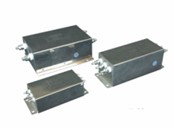EMI Filter
Performance driven EMI filters are used to regulate and protect sensitive electronics from interference. These EMI filters not only drive technology, but are also used in other fields such as telecommunications. EMI filters protect all kinds of electrical apparatus, as all electrical and electronic appliances, equipment and systems have the potential to disturb other ones. Therefore, this must prevent such electromagnetic interference to a level which is acceptable to it’s surroundings. Therefore the noise emission must be low.
Electromagnetic interference can never be completely avoided. Therefore all electrical and electronic apparatus, devices and systems must work satisfactorily regardless of the interference from surrounding electromagnetic fields. There are specific rules to determine which requirements have to be considered in relation to immunity and emissions in each specific case. The standards EN61800-3 (product standard) and EN55011/EN55022 (Limits and methods of measurement) govern the application of the EMI filter. In order to meet these standards, many special measures are required in the design and installation of electrical and electronic systems, such as filtering.
EMI filters for frequency inverters
The following section shows how filters can improve the electromagnetic compatibility of frequency inverters. The functionality of a frequency inverter is achieved by pulsing a DC voltage. This creates a fundamental wave length
ripple. You can unintentionally couple in different ways to other devices, equipments and systems. In addition, a frequency inverter generates electromagnetic waves of high frequency. They can spread in space and inadvertently interfere with the function of the wavelength in equipment and lines thus causing a malfunction. High-energy interference voltage from the mains are a problem for many drives. However, all electrical and electronic apparatus, equipment and systems in the environment of a frequency can be affected by its emissions. The remedy in both cases is an EMI filter at the power supply input. An EMI filter suppresses the high-energy interference voltage from the mains, first by reducing the choke, which is integrated in EMI filter, for the low-frequency disturbance, then other components are integrated in EMI filter to filter out the high-frequency interferences.
Input and output EMI filter
For additional EMC a noise filter is integrated at the power supply input of the frequency inverter. This has two effects. First, it protects against high frequency, grid-bound interference. Secondly, the noise filter reduces the high-frequency interference of the frequency inverter, which is transmitted through the power cord or the radiation of the power cord. Noise filters weakens the noise voltages up to about 1MHz. However another EMC problem appears between the frequency inverter and the consumer. Frequency generates a strong electrical noise on the supply line to the consumer. Various countermeasures are possible to minimize unwanted effects. This includes for example, the installation of an output filter (sine-wave filter) between the inverter and the consumer. In drive technology, this is best placed at the input of the inverter due to fast switching operations and switching high performance to noise. EMI input filters are a summary of suppression chokes and capacity development to RF-tested units that hold a smaller volume. Thus, the assembly for the user is much easier and more comfortable. The resulting noise pulses from anywhere are effectively damped by the EMI filter. The mains filter or input filter is suitable for a frequency inverter with an output between 0.75KW to 250KW, and a mains voltage of 400V.
« Back

